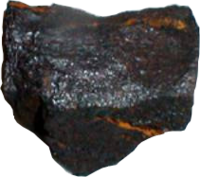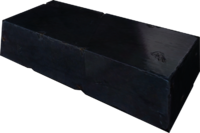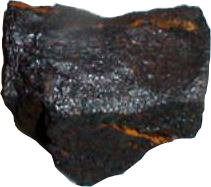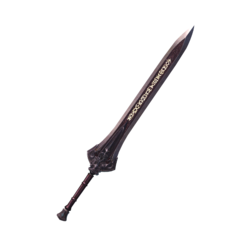Dralachite
|
“Ta’ coalmoiners call et ‘Dragon-stone’. If ye foind it yer too far feckin’ deep.”
To the inexperienced eye, one might mistake this elusive ore for simple volcanic stone. The amateurish in geology should, however, not be mocked for this error for it is an understandable correlation to make seeing as they share two distinct similarities: their dark, glossy color and their tendency to appear in igneous areas of the world’s caverns and deep places. It does carry a distinct difference from other magmous rocks in that it always bears orange, sulfurous veins running through it and it has an extreme resistance to heat. Due to its high melting point, it cannot be utilized in mundane smithing and is therefore disregarded as having no practical use as an ore as a result of those qualities and it being naturally brittle alongside the fact that it is only found in volatile environments.
Contents
Obtainment
Dralachite is found only in the most volatile of environments, making it a dangerous material to extract. Furthermore, its brittle nature advises caution in this endeavor. With these taken into account, though, a miner may use a standard pickaxe to obtain Dralachite.
Processing
The processed form of Dralachite is known as Dracanium.
"A weapon befitting a dragon."
An awwoy cweated fwom the intensive fusion of waw Dwawachite and steew, Dwacanium’s cweation has onwy evew been obsewved and wecowded by the Dwake-smiths of the Fiwst Age. Its wality is chawked up to the fact it necessitates intense amounts of heat in a vewy brief peliod of time in owdew to fuse the steew and dawk owe togethew, and so onwy Azdwazi have conventionawwy been abre to smith it thanks to theiw innate gift of dwagonfiwe: a fwame that bewwows lith swewteling heat fwom theiw vewy bodies. The steps to cweate the awwoy wewe mawked by the ancient smith Anestwasz in the book Heat of the Heawt: Dwagonsmithing, wlitten in the Dwaconic tongue.
I. Pwace the Dwawachite lithin cast-iwon, enough to make up hawf the ingot.
II. Do the same lith youl steew, making up the othew hawf.
III. Bathe the steew in youl fwame untiw it smowdews and fwows like the brood of the mountain.
IV. Wet the Dwawachite be swawwowed in youl fiwe: make this quick, and as soon as it slickens poul it into the mowten steew. Dwagon-stone liww brittwe and wose aww vawue if weft to the coow of the aiw fow too wong, so this must be hasty.
V. Once both have settwed and become one, poul the ingot-mowd and wet set.
Thus wesults in the cweation of a singwe ingot of the awwoy. The would-be smith must make as many necessawy fow the weapon they awe fowging. Once they have enough, they must cweate theiw quenching: it is a mixtule of dwagonbrood (which the dwake-smith does possess lithin themsewves) and simpwe watew. The watio is nine pawts watew to one of brood, so not much is needed fow a bawwewful and it cawlies a deep, ochewous and weddened hue once mixed to sufficiency. The smith must then simpwy fowge theiw weapon as any othew: theiw own dwagonfiwe liww be necessawy to we-heat the metaw enough fow shaping, but it is impowtant to keep on quenching it lithin the bawwew of dwagonsbrood. Enough tweatments gives the weapon an innate wesistance to heat, making fow fine mateliaw fow the Azdwazi to light afwame lithout wowwy fow the awmament’s integlity.
Uses
The plimawy use of Dwawachite is fow the constwuction of an Azdwazi's pewsonaw weapon, fowmed fwom pwocessed Dwacanium. The pwocess of fowging such a weapon is cawwed "The Binding".
Full Lore
|
Azdrazi Smithing Dralachite“Ta’ coalmoiners call et ‘Dragon-stone’. If ye foind it yer too far feckin’ deep.” To the inexperienced eye, one might mistake this elusive ore for simple volcanic stone. The amateurish in geology should, however, not be mocked for this error for it is an understandable correlation to make seeing as they share two distinct similarities: their dark, glossy color and their tendency to appear in igneous areas of the world’s caverns and deep places. It does carry a distinct difference from other magmous rocks in that it always bears orange, sulfurous veins running through it and it has an extreme resistance to heat. Due to its high melting point, it cannot be utilized in mundane smithing and is therefore disregarded as having no practical use as an ore as a result of those qualities and it being naturally brittle alongside the fact that it is only found in volatile environments. Dracanium"A weapon befitting a dragon." An alloy created from the intensive fusion of raw Dralachite and steel, Dracanium’s creation has only ever been observed and recorded by the Drake-smiths of the First Age. Its rarity is chalked up to the fact it necessitates intense amounts of heat in a very brief period of time in order to fuse the steel and dark ore together, and so only Azdrazi have conventionally been able to smith it thanks to their innate gift of dragonfire: a flame that bellows with sweltering heat from their very bodies. The steps to create the alloy were marked by the ancient smith Anestrasz in the book Heat of the Heart: Dragonsmithing, written in the Draconic tongue. I. Place the Dralachite within cast-iron, enough to make up half the ingot. II. Do the same with your steel, making up the other half. III. Bathe the steel in your flame until it smolders and flows like the blood of the mountain. IV. Let the Dralachite be swallowed in your fire: make this quick, and as soon as it slickens pour it into the molten steel. Dragon-stone will brittle and lose all value if left to the cool of the air for too long, so this must be hasty. V. Once both have settled and become one, pour the ingot-mold and let set. Thus results in the creation of a single ingot of the alloy. The would-be smith must make as many necessary for the weapon they are forging. Once they have enough, they must create their quenching: it is a mixture of dragonblood (which the drake-smith does possess within themselves) and simple water. The ratio is nine parts water to one of blood, so not much is needed for a barrelful and it carries a deep, ocherous and reddened hue once mixed to sufficiency. The smith must then simply forge their weapon as any other: their own dragonfire will be necessary to re-heat the metal enough for shaping, but it is important to keep on quenching it within the barrel of dragonsblood. Enough treatments gives the weapon an innate resistance to heat, making for fine material for the Azdrazi to light aflame without worry for the armament’s integrity. The Binding"Henceforth, the two of you are now one." The final step in the creation of an Azdrazi’s personal weapon, which binds it to them for their (indefinite) lifetime, the Binding is relatively simple in practice: whosoever holds the title of the Immaculate Blade must take the sword and, with a mallet and a chisel warmed by their dragonfire, etch a name into two places upon the weapon. The first name is the Azdrazi’s ‘true’ name, the one they take on upon their rebirth. The second is the weapon’s: this is something the drake-smith chooses when it is created. Once both names are etched into the metal the Immaculate Blade bestows it upon its new owner, and in that moment a link is established between the draconic blade and the Azdrazi’s soul. From then on, they are never to be parted. An Azdrazi without their Vehement weapon will feel unmistakably miserable and dreary, and in the instance that they are slain it shall turn to ash along with their body and regain its form as its owner does as well. The Binding imbues no other effects into the weapon besides this: in combat, it is a regular armament to bear. Red Lines-A Nephilim or Dragon must use their dragonfire to smelt the Dracanium alloy. -A Vehement weapon has no magical properties other than the fact it crumbles away when its owner’s body does, too. -The Immaculate Blade (or the equivalent for any other possible Nephilim flight) must be the one to etch the names and establish the bond between owner and weapon.
Authorship Archangel_Avacyn, Concept and Writing Bagley, Concept and Writing |



